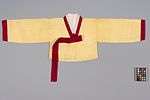jeogori (Jacket)
About this object
History of use
Jeogori made of yellow fabric were worn by brides and young women, generally. If they were small like this one, the woman would have been very young, perhaps thirteen years of age. Brides wore yellow or green jeogori and red skirts (“chima”). Shirts with relatively long sides were worn from 1900. Before that time they were shorter, and the sleeves were narrower. Generally, the ones of this type were worn by rich middle-class women. Those worn by upper-class women had additional coloured panels under the arms and were called “sam-hwae-jang”. Later, prostitutes also liked to wear “sam-hwae-jang”, as they were considered to be beautiful. Modern jeogori would have a neck facing of paper covered with cotton, and an inner burgundy neck band corresponding to that on the outside. The upturned lower edge is characteristic and relates to other graceful curves favoured in Korea, such as the lines of roofs.
Iconographic meaning
The yellow colour indicates that this was worn by a bride.
Specific techniques
The fabric was dyed with natural dyes. The jacket is entirely hand-sewn, with all sewing invisible from the outside and all edges concealed. The layers were sewn together with long stitches that are tiny on the outer surface, and pasted together to hold the shape of the jacket. Korea.
Physical description
Short shirt of yellow fine silk with outer front facings and wrist bands made of burgundy silk, fastened with ties of red silk, doubled and sewn on the inside. The left side laps over the right side to tie. Ties are attached with coarse stitches of green thread. Lining and neck facing are fine white ramie.
Categories
Materials
Date Made
Late Chosun Dynasty (before 1939)
Date Acquired
Aug 1964
How Acquired
Donated
Credit Line
Measurements
Overall: 30.7 cm x 89 cm
Object Number
N3.20
